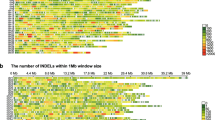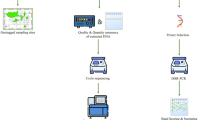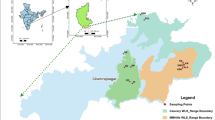Abstract
Opuntia ficus-indica, commonly known as prickly-pear, tuna, or nopal, is a cactus species of economic significance. It is widely cultivated for its fruits and cladodes, used as both fodder and human food. The species would have been domesticated in pre-Hispanic Mexico. In Argentina, two forms are present: the horticultural (spineless, f. ficus-indica) and the wild (spiny, f. amyclaea) forms. The presence/absence of spines would be a genetically controlled trait; thus, the species would have been introduced more than once in our country. A molecular and cytogenetic study was conducted to characterize the genetic variability, infer the source of introduction in Argentina, and explore the relationship between morphotypes. Most spine samples had the Q16-H1 haplotype, except for samples from Mexico, Santiago del Estero, and Catamarca. Samples from Salta, Santiago del Estero, and Catamarca showed morphological differences from O. ficus-indica. The cytological analysis revealed that most populations are octoploid, except for one diploid population from Mexico. Although the number of individuals from Mexico was low, haplotype diversity and number of diploid individuals was higher in that country than in Argentina. The occurrence of a single haplotype of the species associated with both spineless and spiny forms in Argentina reveals a single introduction event and its subsequent dispersion mainly through asexual reproduction. The haplotype diversity found in Argentina is probably due to hybrids between O. ficus-indica and Opuntia species native to this country.





Similar content being viewed by others
References
Adachi J, Watanabe K, Fukui K, Ohmido N, Kosuge K (1997) Chromosomal location and reorganization of the 45S and 5S rDNA in the Brachyscome lineariloba complex (Asteraceae). J Plant Res 110:371–377
Agüero JAR (2005) Variación morfológica de Opuntia (Cactaceae) en relación con su domesticación en la altiplanicie meridional de México. Interciencia 30:476–484
Ahumada L, Montenegro G, Trillo C, Uñates D, Bernardello G, Las Peñas ML (2020) Cytogenetics of tuna in Argentina (two forms of Opuntia ficus-indica (L.) Mill. and O. robusta JC Wendl., Cactaceae). Genet Res Crop Evol 67:645–654
Anderson EF (2001) The cactus family. Timber Press
Baker MA, Pinkava DJ (1987) A cytological and morphometric analysis of a triploid apomict, Opuntia × Kelvinensis (subgenus Cylindropuntia, Cactaceae). Brittonia 39(3):387–401
Baker MA, Pinkava DJ (1999) A new Arizona hybrid cholla, Opuntia× campii (Cactaceae). Cactus Succ J 71:320–322
Bandelt HJ, Forster P, Röhl A (1999) Median-joining networks for inferring intraspecific phylogenies. Molec Biol Evol 16:37–48
Bandyopadhyay B, Sharma A (2000) The use of multivariate analysis of karyotypes to determine relationships between species of Opuntia (Cactaceae). Caryologia 53:121–126
Benson L (1982) The cacti of the United States and Canada. 1–1044 Stanford Univ Press
Benson L, Walkington DL (1965) The southern Californian prickly pears-invasion, adulteration, and trial-byfire. Annals of the Missouri Botanical Garden, 52(3): 262–273
Casas A, Barbera G (2002) Mesoamerican domestication and diffusion. In: Nobel PS (ed) Cacti: biology and uses. University of California Press, pp 143–162
Casas A, Pickersgill B, Caballero J, Valiente-Banuet A (1997) Ethnobotany and domestication in Xoconochtli, Stenocereus stellatus (Cactaceae), in the Tehuacán valley and La Mixteca Baja, México. Econ Bot 51:279–292
Castro JP, Medeiros-Neto E, Souza G, Alves LI, Batista FR, Felix LP (2016) CMA band variability and physical map** of 5S and 45S rDNA sites in Brazilian Cactaceae: Pereskioideae and Opuntioideae. Brazil J Bot 39:613–620
Chessa I, Nieddu G, Serra P, Inglese P, La Mantia T (1996) Isozyme characterization of Opuntia species and varieties from Italian germplasm. III Intern Congr Cactus Pear Cochineal 438:45–56
Chiarini FE, Moreno N, Moré M, Barboza G (2016) Chromosomal changes and recent diversification in the Andean genus Jaborosa (Solanaceae). Bot J Linn Soc 183:57–74
Colunga García-Marín SP, Hernández Xolocotzi E, García Moya E, Castillo Morales A, de Enseñanza CMMI (1984) Variación morfológica, manejo agrícola y grados de domesticación de Opuntia spp. en el Bajío Guanajuatense. Agrociencia 65:7–49
Excoffier L, Lischer HE (2010) Arlequin suite ver 3.5: a new series of programs to perform population genetics analyses under linux and windows. Molec Ecol Res 10:564–567
Flores A, Borrego E, Gómez H, López A (1988) Variabilidad y estudio cromosómico del nopal (Opuntia spp.). Cact Suc Mex 33:91–99
Gerlach WL, Bedbrook JL (1979) Cloning and characterization of ribosomal RNA genes from wheat and barley. Nucleic Acids Res 7:1869–1885
Grabiele M, Chalup L, Robledo G, Seijo G (2012) Genetic and geographic origin of domesticated peanut as evidenced by 5S rDNA and chloroplast DNA sequences. Pl Syst Evol 298:1151–1165
Grant V, Grant KA (1980) Systematics of the Opuntia phaecantha group in Texas. Bot Gaz 140:199–207
Griffith MP (2004) The origins of an important cactus crop, Opuntia ficus-indica (Cactaceae): new molecular evidence. Amer J Bot 91:1915–1921
Griffiths D (1914) Reversion in prickly pears. J Heredity 5:222–225
Gross BL, Olsen KM (2010) Genetic perspectives on crop domestication. Trends in Plant Sc 15:529–537
Hason RE, Islan-Faridi MN, Persival EA, Crane CF (1996) Distribution of 5S and 18S–28S rDNA loci in a tetraploid cotton (Gossypiun hirsutum L.) and its putative diploid ancestors. Chromosome 105:55–61
Hernández-Hernández T, Brown JW, Schlumpberger BO, Eguiarte LE, Magallón S (2014) Beyond aridification: multiple explanations for the elevated diversification of cacti in the new world succulent biome. New Phytol 202:1382–1397
Hershkovitz MA, Zimmer EA (1997) On the evolutionary origins of the cacti. Taxon 46:217–232
Hunt D, Taylor N, Charles G (2006) The new cactus lexicon. DH Books
Kanno H, Seiwa K (2004) Sexual vs. vegetative reproduction in relation to forest dynamics in the understorey shrub, Hydrangea paniculata (Saxifragaceae). Plant Ecol 170:43–53
Kiesling R (1999a) Origen, domesticación y distribución de Opuntia ficus-indica. J Prof Assoc Cactus Dev. 3:50–59
Kiesling R (1999b) Nuevos sinónimos en Opuntia ficus-indica (Cactaceae). Hickenia 2:309–314
Kiesling R (2013) Historia de la Opuntia ficus-indica. Cactusnet Newsletter 13:13–18
Kiesling R, Larrocca L, Faúndez J, Metzing D, Albesiano S (2008) Cactaceae. Monogr Syst Bot Mo Bot Garden 107:1715–1830
Köhler M, Oakley LJ, Font F, Las Peñas ML, Majure LC (2021) On the continuum of evolution: a putative new hybrid speciation event in Opuntia (Cactaceae) between a native and an introduced species in southern South America. Syst Biod 19:1026–1039
Korotkova N, Aquino D, Arias S, Eggli U, Franck A, Gómez-Hinostrosa C, Guerrero PC et al (2021) Cactaceae at Caryophyllales.org—a dynamic online species-level taxonomic backbone for the family. Willdenowia 51:251–270
Larson G, Piperno DR, Allaby RG, Purugganan MD, Andersson L, Arroyo-Kalin M et al (2014) Current perspectives and the future of domestication studies. Proc Natl Acad Sci 111:6139–6146
Las Peñas ML, Kiesling R, Bernardello G (2011) Karyotype, heterochromatin, and physical map** of 5S and 18-5.8-26S rDNA genes in Setiechinopsis (Cactaceae), an Argentine endemic genus. Haseltonia 9:83–90
Las Peñas ML, Oakley L, Moreno NC, Bernardello G (2017) Taxonomic and cytogenetic studies in Opuntia ser. Armatae (Cactaceae). Botany 95:101–120
Las Peñas ML, Urdampilleta JD, Bernardello G, Forni-Martins ER (2009) Karyotypes, heterochromatin, and physical map** of 18S–26S rDNA in Cactaceae. Cytogenet Genome Res 124:72–80
Las Peñas ML, Urdampilleta JD, López-Carro B, Santiñaque F, Kiesling R, Bernardello G (2014) Classical and molecular cytogenetics and DNA content in Maihuenia and Pereskia (Cactaceae). Plant Syst Evol 300:549–558
Las Peñas ML, Bauk K, Rossi N, Bernardello G (2023) Correlations among chromosome numbers, nuclear DNA contents and climatic variables of South American Cactaceae in a phylogenetic context. Biol J Linn Soc. 141(1):87–101
Las Peñas ML, Kiesling R, Bernardello G (2019) Phylogenetic reconstruction of the genus Tephrocactus (Cactaceae) based on molecular, morphological, and cytogenetical data. Taxon 68:714–730
Le Houérou HN (1996) The role of cacti (Opuntia sps.) in erosion control, land reclamation, rehabilitation and agricultural development in the mediterranean basin. J Arid Envir 33:135–159
Lobos E (2006) Control de Cactoblastis cactorum Berg, principal plaga de la tuna en Argentina. In: Ochoa J (ed) Taller de aprovechamiento integral de la tuna, Red Internacional de Cooperación Técnica en Cactus. Universidad Nacional de Santiago del Estero, FAO
Londo JP, Chiang Y-C, Hung K-H, Chiang T-Y, Schaa BA (2007) Phylogeography of Asian wild rice, Oryza rufipogon, reveals multiple independent domestications of cultivated rice, Oryza sativa. PNAS USA 103:9578–9583
Majure LC, Puente R, Pinkava DJ (2012) Miscellaneous chromosome numbers in Opuntieae DC. (Cactaceae) with a compilation of counts for the group. Haseltonia 18:67–78
Mandujano MC, Montaña C, Franco M, Golubov J, Flores-Martínez A (2001) Integration of demographic annual variability in a clonal desert cactus. Ecology 82:344–359
Moreno NC, Amarilla LD, Las Peñas ML, Bernardello G (2015) Molecular cytogenetic insights into the evolution of the epiphytic genus Lepismium (Cactaceae) and related genera. Bot J Linn Soc 177:263–277
Nobel PS, Bobich EG (2002) Environmental biology. In: Nobel PS (ed) Cacti: biology and uses. Berkeley, University of California Press, pp 57–74
Nylander JA (2004) MrModelTest Program distributed by the author. Evolutionary Biology Centre, Uppsala University
Pimienta BE, Muñoz A (1995) Domestication of opuntias and cultivated varieties. In: Barbera G, Inglese P, Pimienta E, Arias E (eds) Agro-ecology, Cultivation and Uses of Cactus Pear. FAO, pp 58–63
Pinkava DJ (2002) On the evolution of the North American Opuntioideae. In: Hunt D, Taylor N (eds) Studies in the Opuntioideae. Royal Botanic Gardens, pp 59–98
Reyes-Agüero JA, Aguirre Rivera JR, Hernández HM (2005) Systematic notes and a detailed description of Opuntia ficus-indica (L.) Mill. (Cactaceae). Agrociencia 39:395–408
Roa F, Guerra M (2012) Distribution of 45S rDNA sites in chromosomes of plants: structural and evolutionary implications. BMC Evol Biol 12:1–13
Rozas J, Sánchez-Del Barrio JC, Messeguer X, Rozas R (2003) DnaSP, DNA polymorphism analyses by the coalescent and other methods. Bioinformatics 19:2496–3249
Sáenz C (2000) Processing technologies: an alternative for cactus pear (Opuntia spp.) fruits and cladodes. J Arid Envir 46:209–225
Scaldaferro MA, Acosta BGE, MC, (2018) Evolutionary history of the chili pepper Capsicum baccatum L. (Solanaceae): domestication in South America and natural diversification in the seasonally dry tropical forests. Biol J Linn Soc 124:466–478
Schwarzacher T, Heslop-Harrison P (2000) Practical in situ hybridization. Bios Scientific Publishers Limited
Segura S, Scheinvar L, Olalde G, Leblanc O, Filardo S, Muratalla A, Flores C (2007) Genome sizes and ploidy levels in Mexican cactus pear species Opuntia (Tourn.) Mill. series Streptacanthae Britton et Rose, Leucotrichae DC., Heliabravoanae Scheinvar and Robustae Britton et Rose. Genet Res Crop Evol 54:1033–1041
Shaw J, Lickey EB, Schilling EE, Small RL (2007) Comparison of whole chloroplast genome sequences to choose noncoding regions for phylogenetic studies in angiosperms: the tortoise and the hare III. Amer J Bot 94:275–288
Soltis PS, Soltis DE (2009) The role of hybridization in plant speciation. Annual Rev Plant Biol 60:561–588
Spencer JL (1955) A cytological study of the Cactaceae of Puerto Rico. Bot Gaz 117:33–37
Stiefkens L, Las Peñas ML, Levin RA, Miller JS, Bernardello G (2020) Chromosome evolution in the cosmopolitan genus Lycium (Solanaceae). Taxon 69:124–141
Stuppy W (2002) Seed characters and the classification of the Opuntioideae. In: Hunt D, Taylor N (eds) Studies in the Opuntioideae (Cactaceae) Succul Plant Res 6. David Hunt Books
Taketa S, Ando H, Takeda K, Harrison GE, Heslop-Harrison JS (2000) The distribution, organization and evolution of two abundant and widespread repetitive DNA sequences in the genus Hordeum. Theor Appl Genet 100:169–176
Tamura K, Stecher G, Peterson D, Filipski A, Kumar S (2013) MEGA6: molecular evolutionary genetics analysis version 6.0. Mol Biol Evol 30:2725–2729
Tel-Zur N, Abbo S, Myslabodski D, Mizrahi Y (1999) Modified CTAB procedure for DNA isolation from epiphytic cacti of the genera Hylocereus and Selenicereus (Cactaceae). Plant Molec Biol Reporter 17:249–254
Turchetto-Zolet AC, Pinheiro F, Salgueiro F, Palma-Silva C (2013) Phylogeographical patterns shed light on evolutionary process in South America. Molec Ecol 22:1193–2121
Yuasa HH, Shimizus S, Kashiwai S, Kondo N (1974) Chromosome numbers and their bearing on the geographic distribution in the Subfamily Opuntioideae (Cactaceae). Rep Inst Breed Res Tokyo Univ Agric 4:1–10
Acknowledgements
The authors thank the Consejo Nacional de Investigaciones Científicas y Técnicas (CONICET), Agencia Nacional de Promoción Científica y Tecnológica (FONCyT), and SECyT (Universidad Nacional de Córdoba, Argentina), research supported in part by the USDA-Mexico Bi-National Cactus Moth Program and by USDA, APHIS-PPQ; Farm Bill Section 10201 and Fondo para la Investigación Científica y Tecnológica (Grant No. 2016-1447) for funding this research. Adriana Perez, Diego Gurvich, Lorena Ashworth, Mariel Guala, Stephen Hight and Guillermo Logarzo provided some samples and Luis Oakley kindly identified the vouchers.
Funding
The authors thank the Consejo Nacional de Investigaciones Científicas y Técnicas (CONICET), Agencia Nacional\ de Promoción Científica y Tecnológica (FONCyT), and SECyT (Universidad Nacional de Córdoba, Argentina), research supported in part by the USDA-Mexico Bi-National Cactus Moth Program and by USDA, APHIS-PPQ; Farm Bill Section 10201 and Fondo para la Investigación Científica y Tecnológica (Grant No. 2016-1447) for funding this research.
Author information
Authors and Affiliations
Contributions
“All authors contributed to the study conception and design. Material preparation, data recording and analysis were performed by Gonzalo Montenegro, M. Cristina Acosta, Luciana Caeiro, Laura Varone, María Laura Las Peñas. The first draft of the manuscript was written by María Laura Las Peñas and all authors commented on previous versions of the manuscript. All authors read and approved the final manuscript.”
Corresponding author
Ethics declarations
Conflict of interest
The authors declare that they have no conflict of interest.
Additional information
Publisher's Note
Springer Nature remains neutral with regard to jurisdictional claims in published maps and institutional affiliations.
Supplementary Information
Below is the link to the electronic supplementary material.
Rights and permissions
Springer Nature or its licensor (e.g. a society or other partner) holds exclusive rights to this article under a publishing agreement with the author(s) or other rightsholder(s); author self-archiving of the accepted manuscript version of this article is solely governed by the terms of such publishing agreement and applicable law.
About this article
Cite this article
Montenegro, G., Acosta, M.C., Caeiro, L. et al. Tracing the geographic origins of two forms of Opuntia ficus-indica cultivated in Argentina using haplotype diversity patterns, and cytogenetic and morphological analyses. Genet Resour Crop Evol (2024). https://doi.org/10.1007/s10722-024-01876-w
Received:
Accepted:
Published:
DOI: https://doi.org/10.1007/s10722-024-01876-w




